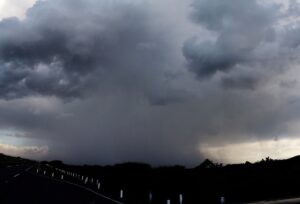In May 2024, downtown Houston saw a surprising twist in storm damage. A powerful downburst, part of a derecho storm, blew out windows and ripped away building facades damage that even Hurricane Beryl, with similar wind speeds, failed to cause just months later. Engineers now believe the reason lies not in the strength of the winds but in how they behave.

What Is a Downburst and Why Is It So Dangerous?
Downbursts are often mistaken for heavy rain from a distance, but their power lies in what happens at ground level. As cold, dense air from high altitudes plunges downward during a thunderstorm, it accelerates rapidly. Once it hits the ground, it has nowhere to go but outwards sending winds blasting horizontally in all directions.
These horizontal gusts can reach over 150 mph on par with a Category 4 hurricane but they behave very differently. Unlike tornadoes, which spin around a vertical axis, downbursts spin around a horizontal axis, forming chaotic patterns that are difficult to predict, especially in dense cityscapes.
Houston: A Real-World Case Study in Wind Behavior
On May 16, 2024, a powerful derecho storm struck Houston, bringing with it a massive downburst that tore through the downtown area. Several high-rise buildings lost windows and suffered facade damage unexpected, since they were built to endure Category 4 hurricanes. One such building, the Chevron Building Auditorium, suffered heavy damage on a side not even directly facing the storm.
Two months later Hurricane Beryl arrived with wind speeds just as strong. Yet it caused minimal structural damage. The question: how could a brief downburst be more destructive than a sustained hurricane?
Simulating Destruction: The Wall of Wind Experiment
To find answers, engineers turned to the Wall of Wind hurricane simulator at Florida International University. With 12 powerful jet fans, the facility can mimic hurricane-force winds, including downbursts.
By recreating both the Houston downburst and Hurricane Beryl conditions, engineers observed how the winds interacted with scaled building models. Their findings were striking:
- Downburst winds concentrated force near the ground and created high-pressure zones on mid-levels of buildings.
- Wind deflected off tall structures, increasing suction on adjacent facades even blowing out windows that weren’t in the storm’s direct path.
- These insights suggest that urban wind channeling and sudden pressure spikes make downbursts exceptionally dangerous, especially in city environments.
- Power Lines Under Pressure
Beyond buildings, power infrastructure is also at risk. Downbursts can collapse transmission towers and cause cascading failures, knocking out electricity for thousands.
Engineers have begun testing new transmission tower designs under simulated downburst conditions. These studies are now influencing updated design manuals used across the U.S., helping to build more resilient power systems.
What About Low-Rise Buildings?
While high-rises have drawn attention, low- and mid-rise buildings may be just as vulnerable. Downburst winds are most violent between 10 and 300 feet precisely where these structures stand.
Short-lived but intense downbursts can cause rapid shifts in wind direction, suction on roofs, and dangerous vibrations, leading to structural failures. Research is now underway to analyze these effects and update building codes to reflect downburst-specific threats.
Cities Must Adapt to a Changing Storm Landscape
As cities grow and storms become more frequent and intense due to climate change, understanding the unique mechanics of downbursts is crucial. Unlike hurricanes or tornadoes, downbursts pack sudden, concentrated power that exploits weaknesses in modern architecture.
With tools like the Wall of Wind and evolving climate models, engineers hope to improve resilience not just for skyscrapers, but for neighborhoods, infrastructure, and the growing urban landscapes of tomorrow.
Because in a world of extreme weather, it’s not just about how strong the wind is but where, when, and how it hits.
